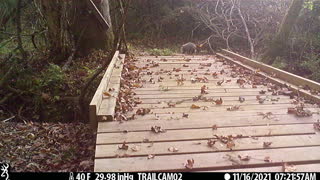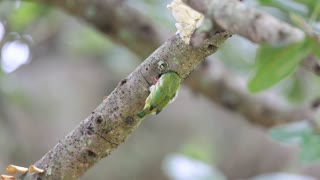The woodpecker is making a nest
Woodpeckers are birds of the order Piciformes. Found worldwide and includes a number of species, usually numbering 218 (including the Ivory-billed Woodpecker). Some woodpeckers in the order Piciformes have zygodactile feet, with 2 toes pointing forward and 2 backwards. The legs, while adapted for gripping on vertical surfaces, can be used for grasping or perching. Some species only have 3 toes. The long tongue found in some woodpeckers can be stuck out to catch insects. The woodpecker gets its name from the habit of some of its species tapping and pecking tree trunks with their beaks. It is a means of communicating territorial ownership by signaling to rivals, and a means of searching for and finding insect larvae under bark or long winding tunnels in trees. At first, woodpeckers search for tunnels by tapping the trunk. Once the tunnel was found, the woodpecker carved the wood until it created an opening into the tunnel. Then stuck his tongue into the tunnel to try to find the grubs. The woodpecker's tongue is long and hooked. With its tongue the woodpecker pierces the grubs and pulls them out of the stem. Woodpeckers also use their beaks to make larger holes for their nests about 15-45 cm (6-18 in) below the exposed surface. The nests are lined only with wood chips and contain 2-8 white eggs that the female lays out. Because out of sight, the nest is invisible to predators and the eggs don't need to be camouflaged. Cavities created by woodpeckers are also reused as nests by other birds, such as some ducks and owls, and mammals, such as tree squirrels.
-
 0:10
0:10
TigerRifle
2 years agoMaking a Nest
32 -
 1:00
1:00
RealPatriotCane
2 years agoA Coppersmith Barbet making a nest
33 -
 0:57
0:57
Bunnyful
2 years agoBunny making nest
22 -
 30:42
30:42
Southwest Mushrooms
1 day agoMushroom Mycelium Tissue Culturing in Liquid and Agar Media | Southwest Mushrooms
953 -
 3:47
3:47
tksgarage
1 day agoTim Kuniskis Out As Dodge CEO!
1.14K2 -
 27:52
27:52
The Bitcoin Family
1 day ago $0.01 earnedBITCOIN 66K, NEXT TARGET IS CLEAR!!!
1.39K6 -
 12:06
12:06
Crypto Crew University
1 day agoWARNING: BITCOIN JUST ENTERED RED ZONE ON WAVE TREND – DO THIS NOW
777 -
 56:53
56:53
LFA TV
13 hours agoRenata Moon | UNCOMMON SENSE IN CURRENT TIMES | 5.18.24 @5pm EST
18.5K23 -
 2:42:39
2:42:39
Jewels Jones Live
1 day agoCOHEN: Perjurer of Congress Lies Again | A Political Rendezvous - Ep. 77
30.1K55 -
 3:08:47
3:08:47
Total Horse Channel
8 hours agoOld Fort Days Futurity & Super Derby
38.4K4